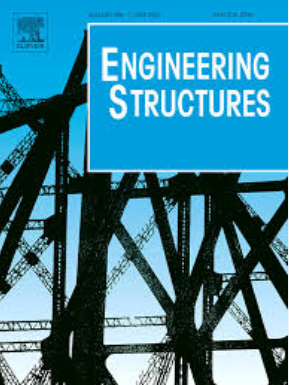串联主缆的尾迹诱发振动:从风洞试验中的柔性和刚性模型的见解
IF 5.6
1区 工程技术
Q1 ENGINEERING, CIVIL
引用次数: 0
摘要
为适应悬索桥跨径的增大,提出了采用串联主缆的方案。为了深入了解从塔架鞍座到锚杆的可变中心间距串联主缆的尾迹诱导振动(WIV)特性,采用两组不同比例的柔性模型和一组刚性节段模型进行风洞试验。考察了上、下游缆索中心间距、风攻角和湍流强度对模型缆索WIV的影响。并对刚性接头抑制模型电缆的WIV的有效性进行了评价。研究结果表明,变中心间距的串串电缆在顺流和湍流中都容易受到严重的WIV影响。振动幅值和主导模态随风速和风攻角的变化而变化。变中心间距串联电缆发生WIV取决于上下游电缆之间较小的间距,而较大的间距影响WIV的临界风速。与预期相反,刚性连接器在特定条件下会放大WIV响应,这强调了在桥梁设计阶段评估此类缓解策略的重要性。本文章由计算机程序翻译,如有差异,请以英文原文为准。
Wake-induced vibrations of tandem main cables: Insights from flexible and rigid models in wind tunnel tests
In order to accommodate the increasing span lengths of suspension bridges, the scheme of adopting tandem main cables was proposed. To provide valuable insights into the wake-induced vibration (WIV) characteristics of tandem main cables with variable center-to-center spacings from the pylon saddle to the anchor, wind tunnel tests were conducted using two sets of flexible models with different scaling ratios and one set of rigid segmental models. The effects of center-to-center spacings between upstream and downstream cables, wind angle of attack, and turbulence intensity on WIV of the model cables are examined. The effectiveness of rigid connectors on suppressing the WIV of the model cables was also evaluated. The findings indicate that the tandem cables with variable center-to-center spacings are susceptible to severe WIV in both smooth flow and turbulence flow. The vibration amplitudes and dominant modes change with the wind speed and wind attack angle. The occurrence of WIV in tandem cables with variable center-to-center spacings depends on the small spacings between the upstream and downstream cables, while large spacings affect the critical wind speed for WIV. Contrary to expectations, rigid connectors were found to amplify the WIV response in specific condition, emphasizing the importance of evaluating such mitigation strategies in bridge design stage.
求助全文
通过发布文献求助,成功后即可免费获取论文全文。
去求助
来源期刊

Engineering Structures
工程技术-工程:土木
CiteScore
10.20
自引率
14.50%
发文量
1385
审稿时长
67 days
期刊介绍:
Engineering Structures provides a forum for a broad blend of scientific and technical papers to reflect the evolving needs of the structural engineering and structural mechanics communities. Particularly welcome are contributions dealing with applications of structural engineering and mechanics principles in all areas of technology. The journal aspires to a broad and integrated coverage of the effects of dynamic loadings and of the modelling techniques whereby the structural response to these loadings may be computed.
The scope of Engineering Structures encompasses, but is not restricted to, the following areas: infrastructure engineering; earthquake engineering; structure-fluid-soil interaction; wind engineering; fire engineering; blast engineering; structural reliability/stability; life assessment/integrity; structural health monitoring; multi-hazard engineering; structural dynamics; optimization; expert systems; experimental modelling; performance-based design; multiscale analysis; value engineering.
Topics of interest include: tall buildings; innovative structures; environmentally responsive structures; bridges; stadiums; commercial and public buildings; transmission towers; television and telecommunication masts; foldable structures; cooling towers; plates and shells; suspension structures; protective structures; smart structures; nuclear reactors; dams; pressure vessels; pipelines; tunnels.
Engineering Structures also publishes review articles, short communications and discussions, book reviews, and a diary on international events related to any aspect of structural engineering.
 求助内容:
求助内容: 应助结果提醒方式:
应助结果提醒方式:


